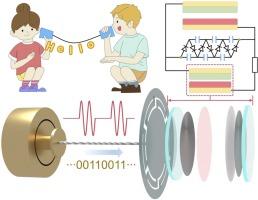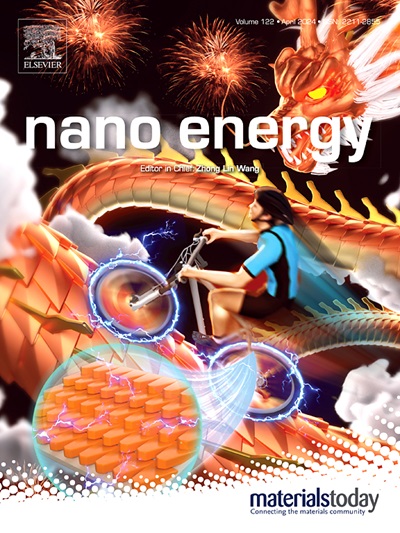铁罐电话启发的自供电机械波通信与自充电激发三电纳米发电机集成
IF 16.8
1区 材料科学
Q1 CHEMISTRY, PHYSICAL
引用次数: 0
摘要
作为电磁波通信的替代品,机械波(MW)在成本效益、简便性、抗干扰性和短距离传输等几个方面保持着优势。本文提出了一种串振自供电机械波通信系统(SSMWC)。受铁罐电话的启发,调制电压信号通过振动器转换为机械波,然后沿弦传输到接收器。接收器集成了一个弦振动三电纳米发电机(SV-TENG)和一个自充电激励三电纳米发电机(SCE-TENG)。SV-TENG 可以在没有外部电源的情况下探测 MW 并将其转换为电信号,而 SCE-TENG 的集成则是为了提高接收器的灵敏度。在对 SCE-TENG 进行充电泵浦后,SV-TENG 在 0-1000 Hz 频率范围内的平均输出可增加 88 倍,这表明自充电激励首次成功应用于三电传感。此外,信息编码和实时解码的演示证明了 SSMWC 作为一种替代方法在特定环境中的潜在应用。这项工作表明,三电传感器所面临的瓶颈已被突破,即封装前必不可少的预备接触电气化,这确实会影响灵敏度和耐用性。因此,该方案可广泛应用于增强输出,尤其是输出较低的三电传感器。本文章由计算机程序翻译,如有差异,请以英文原文为准。

Tin can telephone-inspired self-powered mechanical wave communication integrated with self-charge excitation triboelectric nanogenerator
As an alternative to electromagnetic wave communication, mechanical waves (MW) retain their advantage in several aspects, including cost-effectiveness, simplicity, interference resistance, and short-distance transmission. Here, a string-vibrated self-powered mechanical wave communication system (SSMWC) is proposed. Inspired by tin can telephone, modulated voltage signals are converted into MW by a vibrator and then transmitted along a string to the receiver. The receiver integrates a string-vibrated triboelectric nanogenerator (SV-TENG) and a self-charge excitation triboelectric nanogenerator (SCE-TENG). The SV-TENG can detect MW and convert them into electrical signals without external power sources, while the SCE-TENG is integrated to improve the sensitivity of the receiver. After charges pumping of SCE-TENG, the average output of SV-TENG can increase by 88 times within the frequency range of 0–1000 Hz, indicating the successful application of self-charge excitation in triboelectric sensing for the first time. Furthermore, a demonstration of information coding and real-time decoding proves the potential application of SSMWC as an alternative in specific environments. This work shows the breakthrough of the bottlenecks faced by triboelectric sensors that the essential preparatory contact electrification before packaging, which indeed affect sensitivity and durability. Therefore, this scheme can be widely applied for output enhancement, especially for triboelectric sensors with lower output.
求助全文
通过发布文献求助,成功后即可免费获取论文全文。
去求助
来源期刊

Nano Energy
CHEMISTRY, PHYSICAL-NANOSCIENCE & NANOTECHNOLOGY
CiteScore
30.30
自引率
7.40%
发文量
1207
审稿时长
23 days
期刊介绍:
Nano Energy is a multidisciplinary, rapid-publication forum of original peer-reviewed contributions on the science and engineering of nanomaterials and nanodevices used in all forms of energy harvesting, conversion, storage, utilization and policy. Through its mixture of articles, reviews, communications, research news, and information on key developments, Nano Energy provides a comprehensive coverage of this exciting and dynamic field which joins nanoscience and nanotechnology with energy science. The journal is relevant to all those who are interested in nanomaterials solutions to the energy problem.
Nano Energy publishes original experimental and theoretical research on all aspects of energy-related research which utilizes nanomaterials and nanotechnology. Manuscripts of four types are considered: review articles which inform readers of the latest research and advances in energy science; rapid communications which feature exciting research breakthroughs in the field; full-length articles which report comprehensive research developments; and news and opinions which comment on topical issues or express views on the developments in related fields.
 求助内容:
求助内容: 应助结果提醒方式:
应助结果提醒方式:


